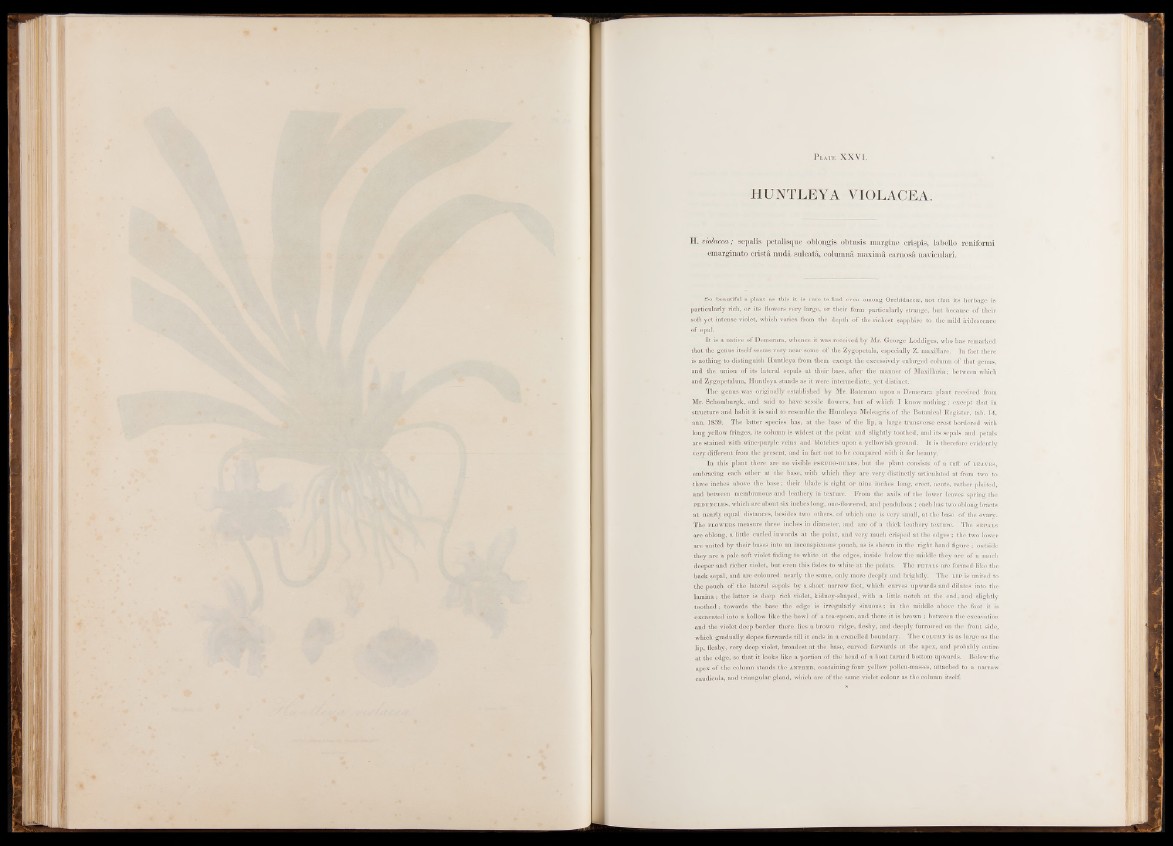
P late X X V I .
HUNTLEYA VIOLACEA.
H. molacea ; sepalis petalisque oblongis obtusis margine crispis, labello reniformi
emarginato cristâ nudâ sulcata, columnâ maximâ carnosâ naviculari.
So beautiful a plant as this it is rare to find even among Orchidacèæ, not that its herbage is
particularly rich, or its flowers very large, or their form particularly strange, but because of their
soft yet intense violet, which varies from the depth of the richest sapphire to the mild iridescence
of opal.
It is a native of Demerara, whence it was received by Mr. George Loddiges, who has remarked
that the genus itself seems very near some of the Zygopetala, espècially Z. maxillare. In fact there
is nothing to distinguish Huntleya from them except the excessively enlarged column of that genus,
and the union- of its lateral sepals at their base, after the manner of Maxillaria ; between which
and Zygopetalum, Huntleya stands as it were intermediate, yet distinct.
The genus was originally established by Mr. Bateman upon a Demerara plant received from
Mr. Schomburgk, and said to have sessile flowers, but of which I know nothing; except that in
structure and habit it is said to resemble the Huntleya Meleagris of the Botanical Register, tab. 14,
ann. 1839. The latter species has, at the base of the lip, a large transverse crest bordered with
long yellow fringes, its column is widest at the point and slightly toothed, and its sepals and petals
are stained with wine-purple veins and blotches upon a yellowish ground. It is therefore evidently
very different from the présent, and in fact not to be compared with it for beauty.
In this plant there are no visible p s e u d o -b u l b s , but the plant consists of a tuft of l e a v e s ,
embracing each other at the base, with which they are very distinctly articulated at from two to
.three inches above the base; their blade is eight or nine inches long, erect, scute, rather plaited,
and between membranous and leathery in texture. From thé axils of the lower leaves spring the
p e d u n c l e s , which are about six inches long, one-flowered, and pendulous ; each has two oblong bracts
at nearly equal' distances, besides two others, of which one is very small, at the base of the ovary.
The f l o w e r s measure three inches in diameter, and are of a thick leathery texture. The s e p a l s
are oblong, a little curled inwards at the point, and very much crisped at the edges ; the two lower
are united by their bases into an inconspicuous pouch, as is shewn in the right hand figure ; outêide
they are a pale soft violet fading to white at the edges, inside below the middle they are of a much
deeper and richer violet, but even this fades to white at the points. The p e t a l s are formed like the
back sepal, and are coloured nearly the same, only more deeply and brightly. The l i p is united to
the pouch of the lateral sepals by a short narrow foot, which curves upwards and dilates into the
lamina ; the latter is deep rich violet, kidney-shapéd, with a little notch at the end, and slightly
toothed ; towards the base the edge is irregularly sinuous ; in the middle above the foot it is
excavated into a hollow like the bowl of a tea-spoon, and there it is brown ; between the excavation
and the violet deep border there lies a brown ridge, fleshy, and deeply furrowed on the front side,
which gradually slopes forwards till it ends in a crenelled boundary. The column is as large as the
lip, fleshy, very deep violet, broadest at the base, curved forwards at the apex, and probably entire
at the edge, so that it looks like a portion of the head of a boat turned bottom upwards. Below the
apex of the column stands the a n t h e r , containing four yellow pollen-masses, attached to a narrow
caudicula, and triangular gland, which are of the same violet colour as the column itself.